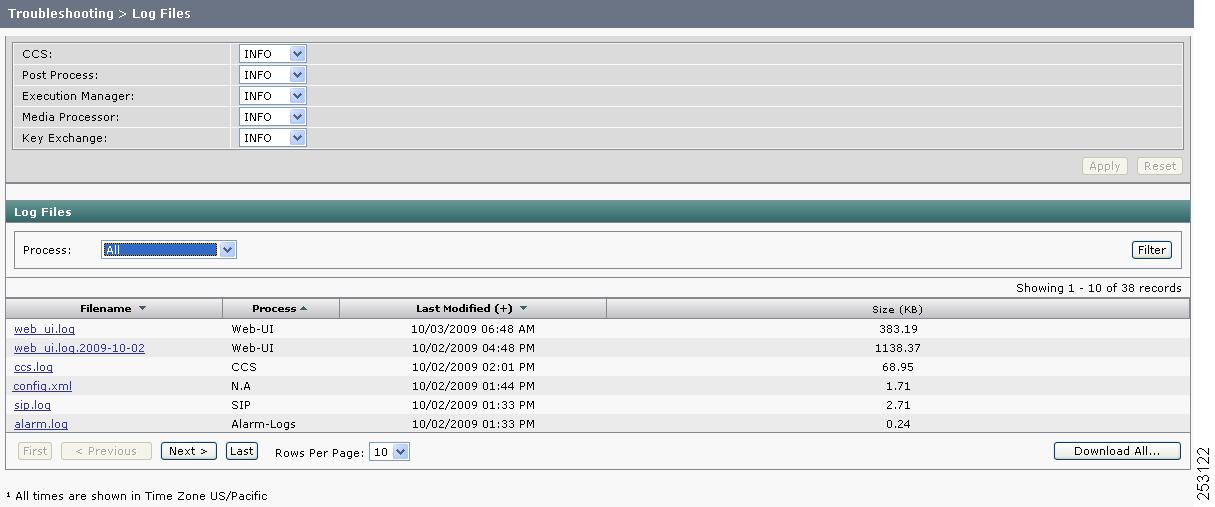

Table Of Contents
CTRS Alarms and System Errors Messages
Troubleshooting CTRS
Revised: November 2009The following sections describe the Troubleshooting tools for the Cisco TelePresence Recording Server (CTRS):
•
CTRS Alarms and System Errors Messages
CTRS Alarms and System Errors Messages
You can view CTRS alarms, systems error and system warning messages in one of two ways:
•
Click System Errors in the left menu (see Figure 6-1). The System Errors screen displays a list of all warning and error messages.
Figure 6-1 Troubleshooting > System Errors
•
From the System Status bar, click the icon for Warnings or Errors.
The following table provides field descriptions for all system error and warning displays:
•
To display a defined number of table rows, click the down arrow next to Rows Per Page. Click to highlight and select predetermined amounts.
•
If there are multiple pages listing log files, click the First, Previous, Next, or Last button to navigate to the desired page.
•
To delete one of the system error messages, click the radio button to the left of the table entry, and then click Clear.
•
To delete all error messages displayed, click Clear All.
Log Files
Click Log Files in the left menu to display or modify log information (see Figure 6-2).
Figure 6-2 Troubleshooting > Log Files
Use the Log File screen to set severity levels for alarms associated with specific system processes, to filter log files displayed, and to download log files.
Configuring the Severity Level of System Error Messages
To configure the severity level of system level error messages and alarms for specific process areas:
Step 1
Click Log Files under Troubleshooting in the left menu to access the Log Files screen.
Step 2
At the top of the Log Files screen, there is a table listing the following CTRS system processes:
•
CCS
•
Post Processor
•
Execution Manager
•
Media Processor
•
Key Exchange
To the right of each process is a drop-down list, listing the following severity levels:
•
OFF
•
CRIT
•
ERROR
•
WARN
•
INFO
•
DEBUG
Click the down arrow to display the drop-down list of defined levels of severity, and then highlight to select a specific severity level for all error messages and alarms associated a particular CTRS system process.
Note
Log levels create varying amounts of data; for example, DEBUG creates more log entries than CRIT. Because verbose logs can impact system performance, use verbose logs only to track a problem.
Filtering the Log File Table Listings
To filter the log files displayed in the Log File Table:
Step 1
Click Log Files under Troubleshooting in the left menu to access the Log Files screen.
Step 2
At the middle of the Log Files screen, click the down arrow to the right of Processes to display a list of CTRS process areas, then click to highlight and select a specific process area on which to filter log files. Choices are the following:
•
All
•
CCS
•
Execution Manager
•
Media Processor
•
Post Process
•
Key Exchange
•
SIP
•
Web-UI
•
CDR Logs
•
Core
•
Alarm Logs
•
CTRS Sysop
Step 3
Click the Filter button to display the logs files associated with the selected process area in the Log Files table.
Downloading Log Files
To download log files from the Log File table:
Step 1
Click Log Files under Troubleshooting in the left menu to open the Log Files screen.
Step 2
At the bottom of the Log Files screen is the Log File table, which lists the available log files. The table is organized as described in Table 6-2.
Step 3
To display a defined number of table rows, click the down arrow next to Rows per Page. Click to highlight and select predetermined amounts. If there are multiple pages listing log files, click the First, < Previous, Next >, or Last button to navigate to the desired page.
Step 4
Click the filename of a log file to download that file. Click the Download All button to download all log files listed.

 Feedback
Feedback


